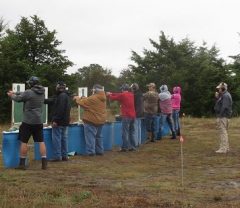by Sandy Keathley
McKinneyFirearmsTraining.com
Lately, I’ve had several women in pistol classes, and found that some of them had great difficulty in racking the slide on a semi-automatic. That is not surprising; as a general rule, women tend to have less grip strength than men, especially when those women are small-boned, older, or generally not inclined toward athletic activities. Certainly, this is not a problem for many women, especially younger ones, many of whom participate in competitive shooting (or athletics), and hold their own against men.
However, that difference in grip strength should not preclude a woman from being able to have protection at home. With that in mind, here are some thoughts on guns that all women would be able to safely and reliably operate.
Semi-auto:
The force required to rack the slide is not the same for all models. It depends on the design, and the quality of manufacturing. As always, you get what you pay for. Go to a gun show, and test every 9mm you can. You will find that some are easier than others. Unfortunately, cheaper ones will tend to be harder than more expensive models. I specify 9mm because larger calibers will tend to have stronger slide return springs. A 9mm is generally thought to have the minimum required stopping power. You might find that a .380 is much easier to rack, but that may not have enough stopping power to stop a home invasion. Keep reading.
Revolver:
I personally think this is the ideal home defense weapon. True, it only holds 6-7 rounds, instead of the 10-18 of a full-size semi, but if you need more than 6, you have other problems, anyway. It is idiot-proof; you don’t have to remember how to work it, whether or not there is a safety, which way to take it off safety; just point and pull, and it never jams. The problem for a revolver is that it has much more recoil than a semi, but that is mitigated if the gun is all-steel, has a long barrel, or both. Revolvers intended for concealed carry are painful to shoot, but an all-steel Colt or Smith & Wesson with a 4-6 inch barrel is an easy shooter, very accurate, and can be managed by anyone. If the trigger pull is hard, just cock it with your left thumb. If you break into my house, and get past my dogs, that is what you will face!
If that is too big for you, consider a revolver in .22 Magnum. It is much more powerful than a normal .22, in a small package. A .22 may be lethal, but may not be lethal fast enough to save you. However, it is better than nothing, and a .22 Magnum will get their attention.
Zippering:
Here is a novel solution; a high-capacity .22. During WWII, in places like France, Italy, and Poland, partisan guerillas took out sentries at Nazi locations like railway stations and ammo dumps with small caliber pistols like .22 or .32. They were quiet and drew no attention. They were short on stopping power, but the partisans “zippered” the guards. Instead of shooting 3 times at the same place, they shot them 6-10 times in a pattern from the upper chest to the lower abdomen. Even when it wasn’t fatal, the guard was in serious trouble, as he was bleeding from multiple locations, and could not stop the bleeding, even with two hands.
Several manufacturers, like Ruger and German Sport Guns, make .22 pistols in a large form factor, like a 1911 design, with a capacity of 10-14 rounds. These target pistols are very easy to shoot, and very accurate at 25 yards or more. The recoil is so little, and the sight-picture reacquisition so fast, that you can hit a burglar 10 times in under 4 seconds. Stopping power is not an issue when he has 8-10 wounds.
Even more solutions:
IF there are no children in the house, get a semi-automatic rifle. S&W makes a .22 rifle with a 25-round magazine. Talk about zippering! These are even easier to aim and shoot than the pistols. If you want more stopping power, get a rifle chambered in .223 (or 5.56). Despite the odd numbering system, this is nowhere near a .22; this is a true combat rifle. The .223 has less recoil than the 5.56, but is still manageable, and has all the punch you could ever need.
There are many solutions to the home defense problem, and the Internet can give you much information to maximize your self-defense plan. Just search. Write me with questions.





